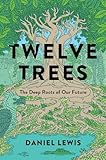“Twelve Trees” focuses on rare and mostly endangered tree species. As suggested by the title, author Daniel Lewis has written essays on a dozen tree species from around the world with a focus not only on their botanical qualities and ecological role, but also their importance to human culture.
Each chapter begins with a stylized image of its subject by Eric Nyquist, but otherwise there are no illustrations. Fortunately, Lewis is a talented writer. “I’ve chosen twelve trees that have been on long journeys, have many accomplices as well as enemies, and need our help to survive.” This last part is key, as several of the trees are at risk due to human interference, including climate change.
 Some of the twelve trees will be quite familiar, such as the coast redwoods (Sequoia sempervirens). Others, such as the gigantic ceiba (Ceiba pentandra) of Central and South America, may be new to readers. New to me was the toromiro (Sophora toromiro), a small tree that is no longer found on its native island of Rapa Nui, also known as Easter Island, although there are efforts to restore it. One chapter even profiles an extinct tree, Humenaea protera, that is the source of much of the world’s amber or fossilized resin.
Some of the twelve trees will be quite familiar, such as the coast redwoods (Sequoia sempervirens). Others, such as the gigantic ceiba (Ceiba pentandra) of Central and South America, may be new to readers. New to me was the toromiro (Sophora toromiro), a small tree that is no longer found on its native island of Rapa Nui, also known as Easter Island, although there are efforts to restore it. One chapter even profiles an extinct tree, Humenaea protera, that is the source of much of the world’s amber or fossilized resin.
Animals associated with the featured trees are an important component of these stories. The giant harpy eagle nests in ceiba trees. The Clark’s nutcracker helps spread seeds of bristlecone pines (Pinus longaeva). African elephants are a threat to baobab trees (Adansonia digitata), destroying them to find a source of water in a drying climate.
Only one of the featured trees is a major food source for humans: the olive tree (Olea europaea). This has been an essential agricultural crop for at least 3,000 years. Even the English word “oil” is derived from the Greek word for olive oil. The process to ensure good quality for consumers involves an intricate process of taste testing. “It’s a functional food that works across cultural, geographic, and socioeconomic boundaries.”
Reviewed by: Brian Thompson on August 19, 2024
Excerpted from the Fall 2024 issue of the Arboretum Bulletin